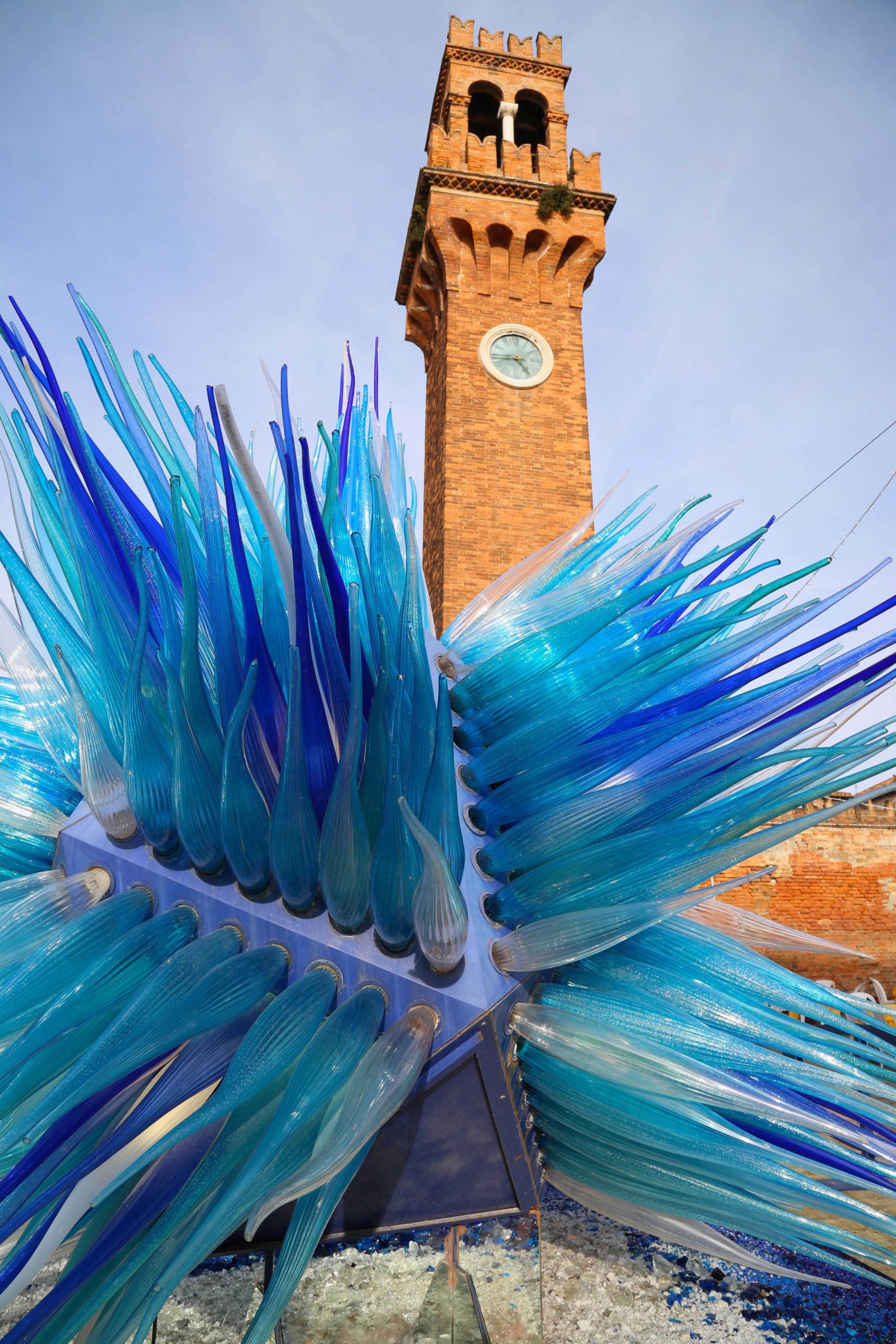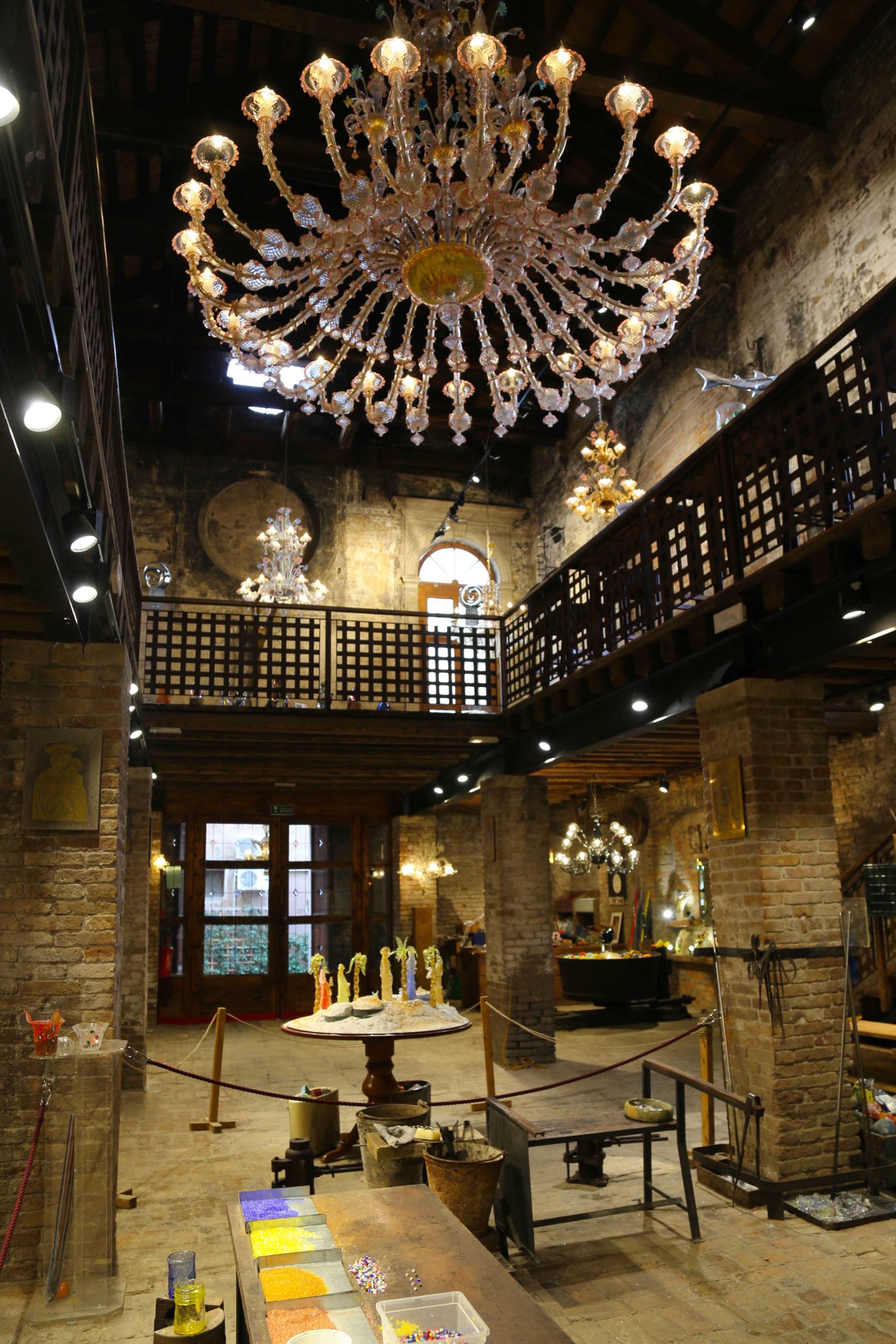
Murano is renowned for producing some of the finest hand-created glass products in the world. The chandelier, above, is just one of thousands of one-of-a-kind pieces that have been produced for centuries on the island.
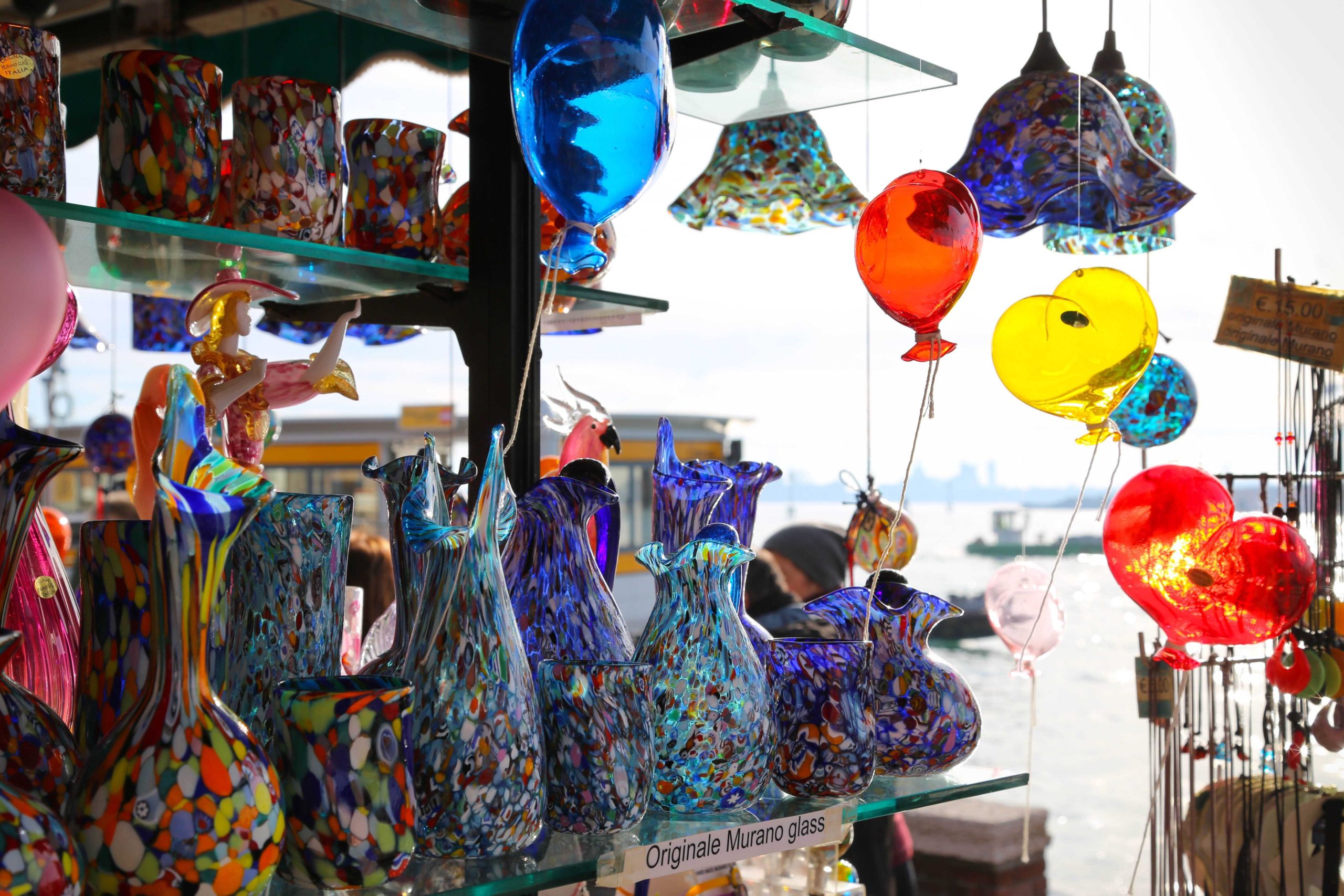
Glass products from Murano are still highly prized, but nowadays tourists and visitors are drawn to more affordable items like these colorful decorative items.
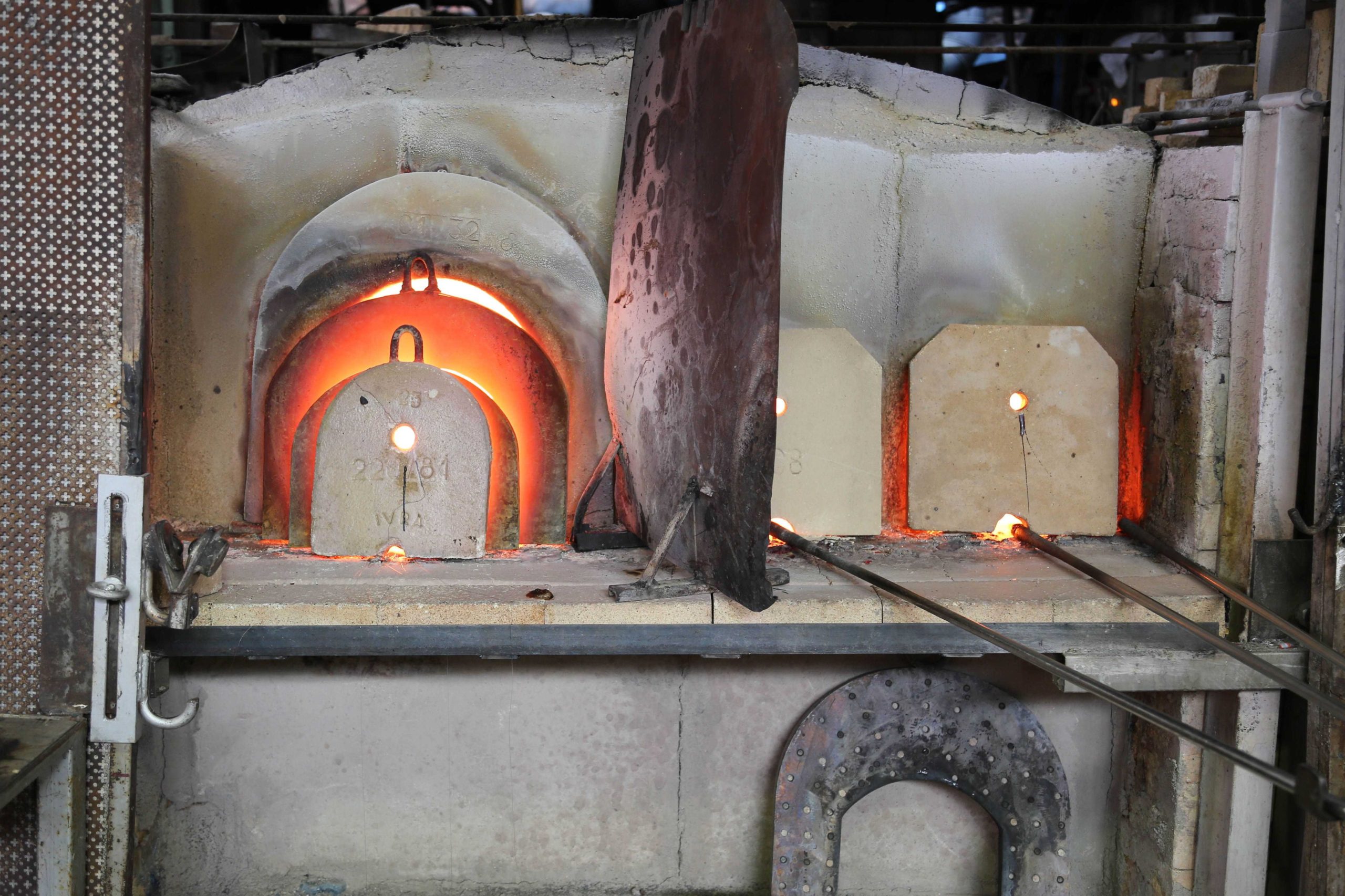
There are three heating vessels related to making glass products. A ‘furnace’ contains molten glass that is picked up by a blow pipe. Above, a ‘glory hole’ keeps the end of the blow pipe hot (and also the glory hole is used to keep the piece soft so the craftsman can work and shape the material). Once the piece is completed, it is placed in an ‘annealing oven’ to permit slow cooling and allow the internal stresses within the glass a chance to relax.
Western Civilization owes a debt of gratitude to the many innovations that sprang from the islands in the Venetian Lagoon; art, architecture, sculpture, commerce, and banking are just a few. Another example is glass making, prominent there since craftsmen began turning out products as early as 450 A.D. The small islands that comprise Murano became the center for some of the world’s finest glass products – a reputation that continues to this day.

There are still a number of glass making studios on Murano, though the total number has dwindled over the years. Nonetheless, there are beautiful pieces of glass art and products to satisfy almost any taste at each and every studio.
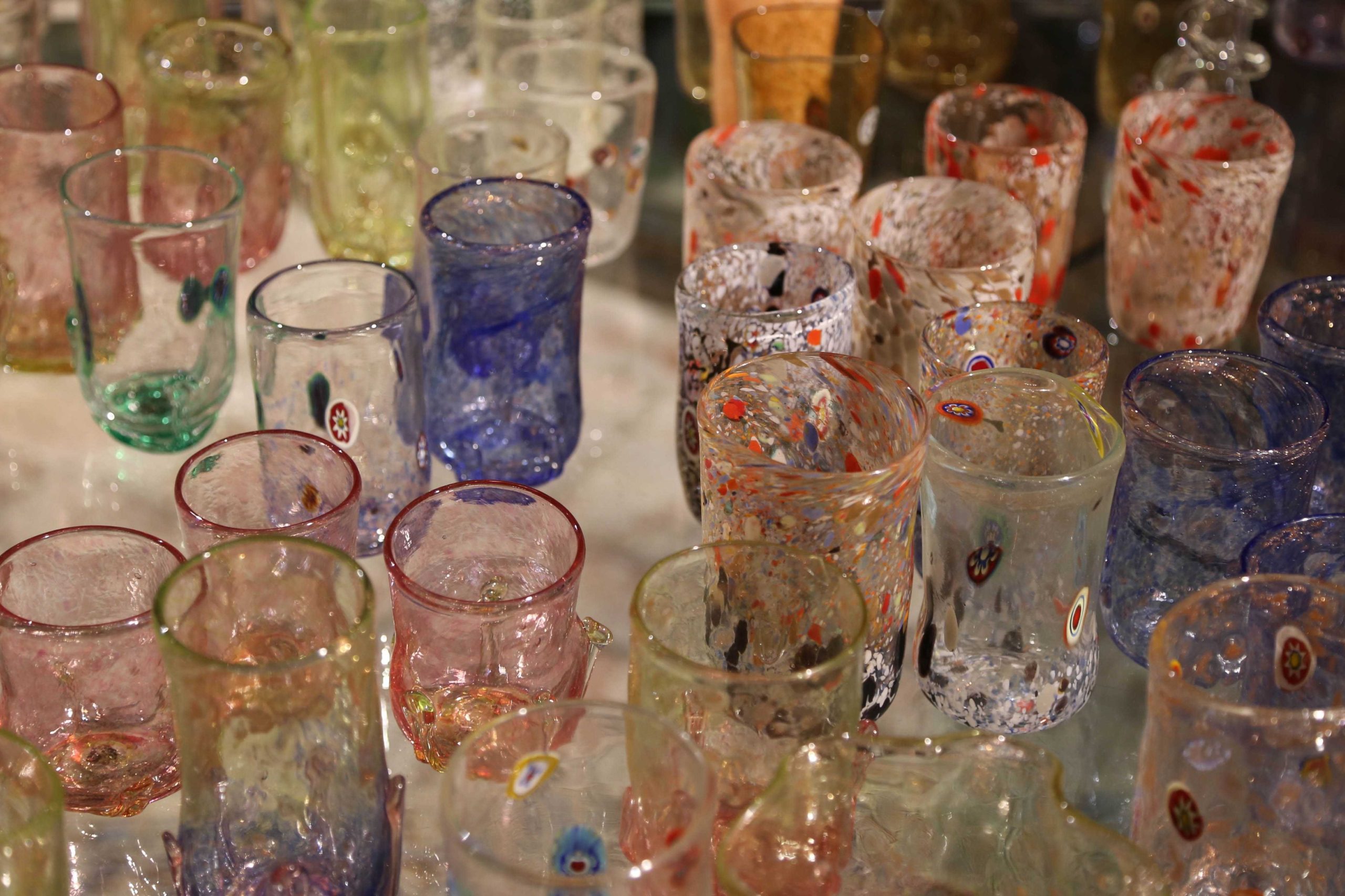
Savvy glass makers know that shoppers are eager to purchase small items like these apertif glasses that can easily fit into a suitcase and become a cherished memento for years.
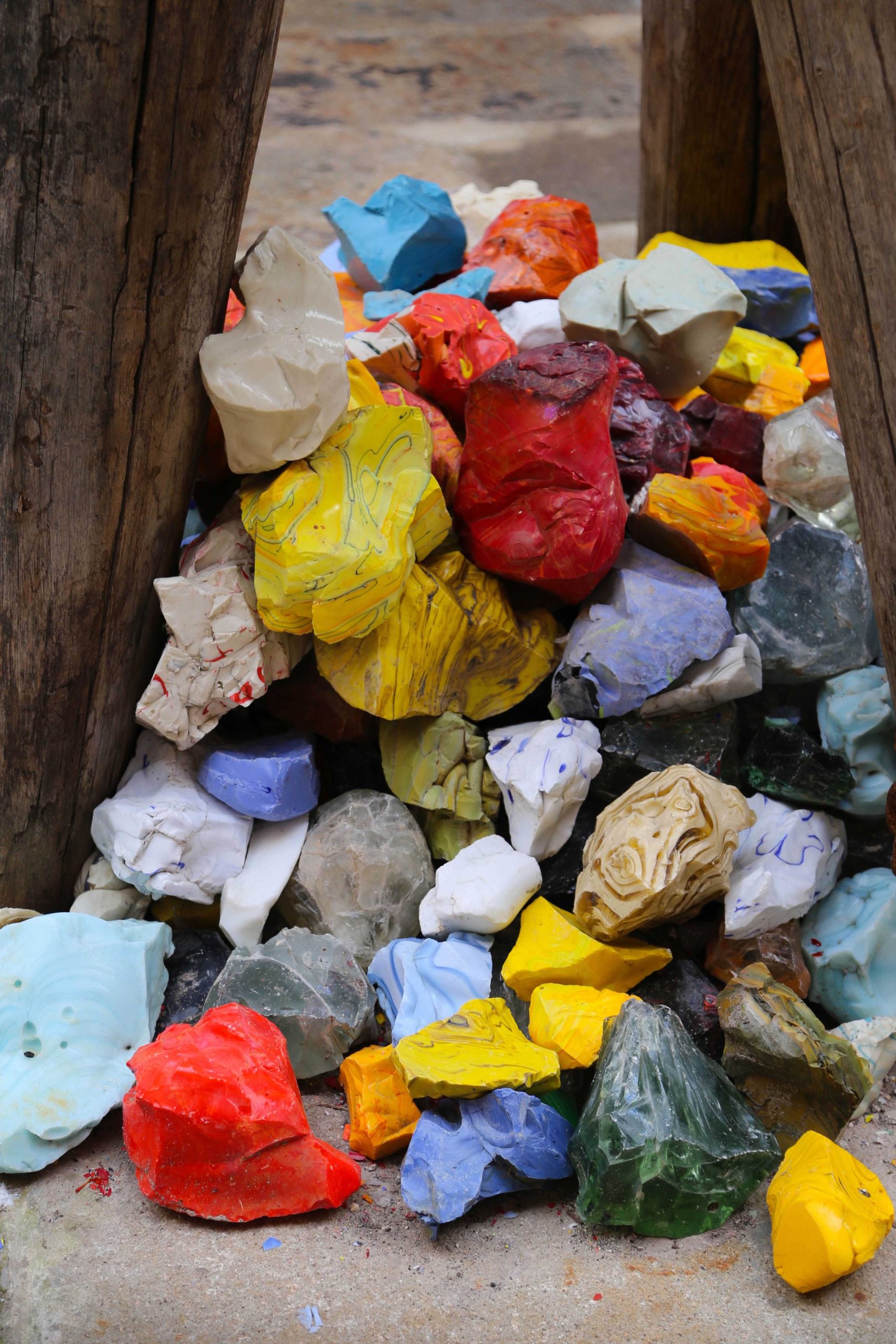
Glass is versatile, and colored glass can be mixed in, blended, or used as accents to give each piece a distinctive look.
The early inhabitants of the lagoon’s 118 small islands were a far cry from the heyday that would become the Venetian Republic. But by 1000 A.D. Venice was on her way, and for glass makers, November 8, 1291 marked a significant date. The Venice governing council, headed by the Doge, dictated that the enormous furnaces required for glass making were a fire danger to a city built (at the time) mostly of wood, resting on timbers driven deep into a muddy lagoon. The order was given – relocate all the glassmaking studios to Murano.
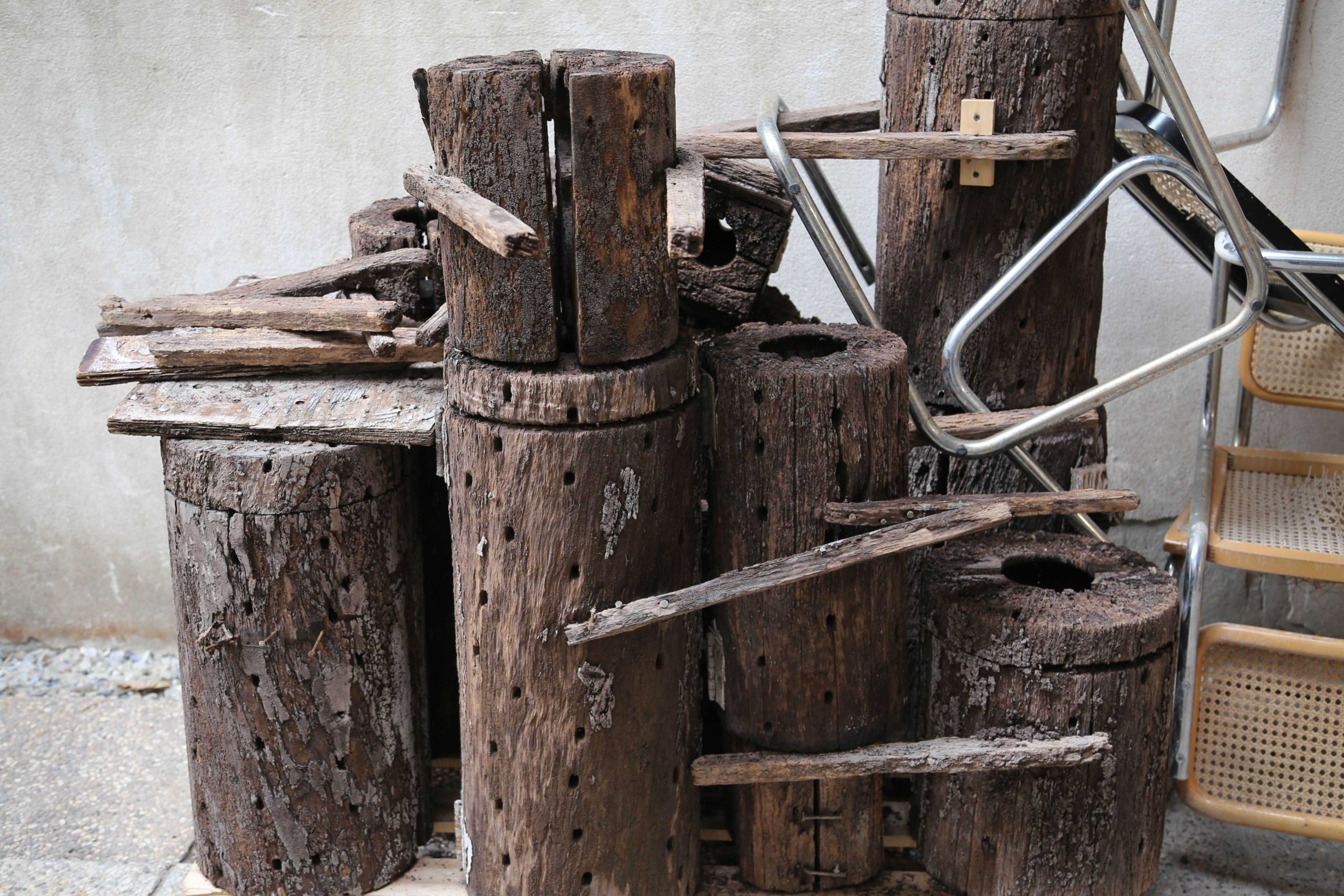
Wooden molds were once used to create glasses, bottles and other blown products. Molds were soaked in water to keep the wood from catching fire.

A range of colors and patterns of glass can be used by itself, or mixed in with clear glass to give products an endless array of colors.
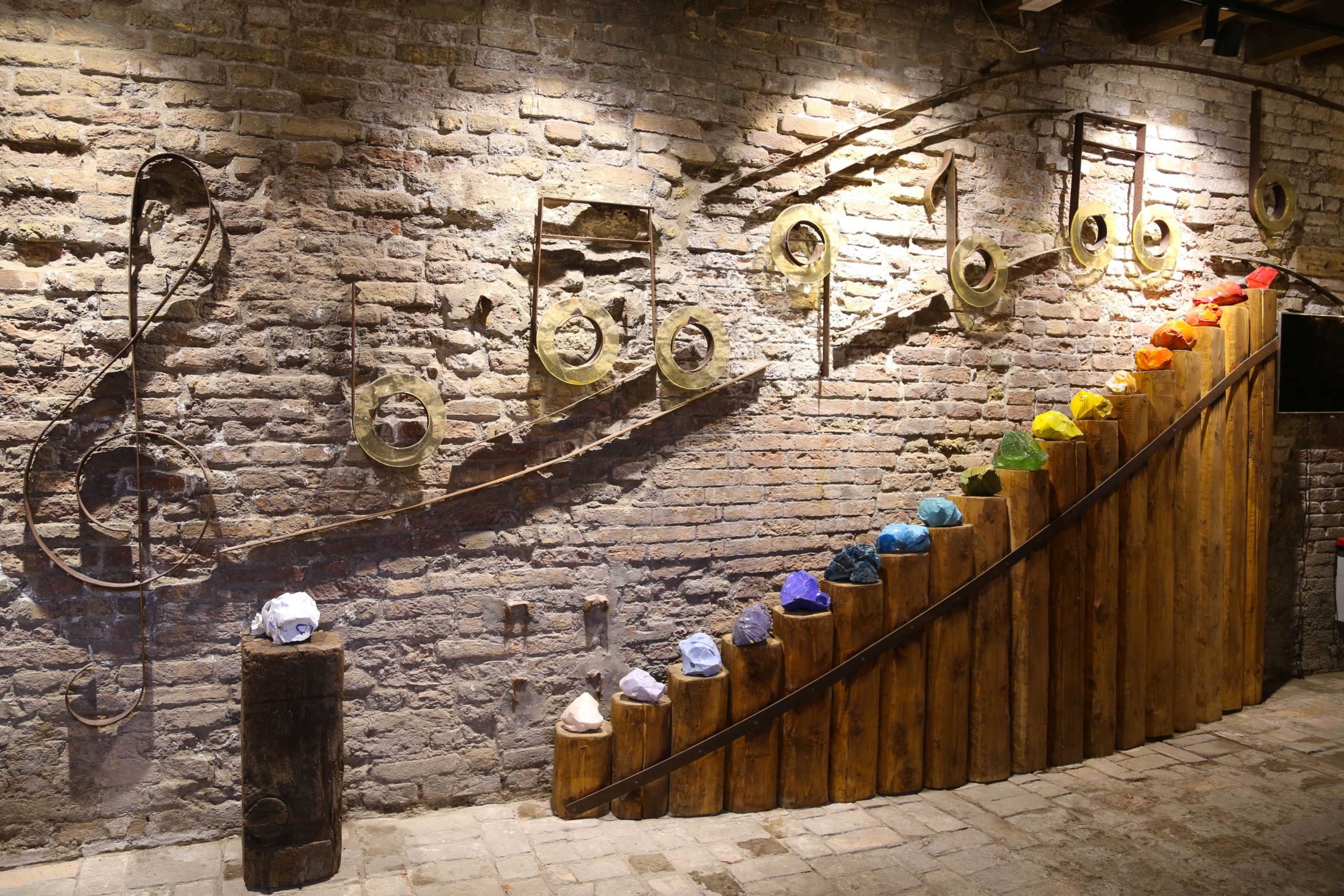
A glass studio’s showroom welcomes visitors and customers.

Murano is one of the 118 small islands in the Venetian Lagoon. The glass making island is just 1.2 miles from Venice.
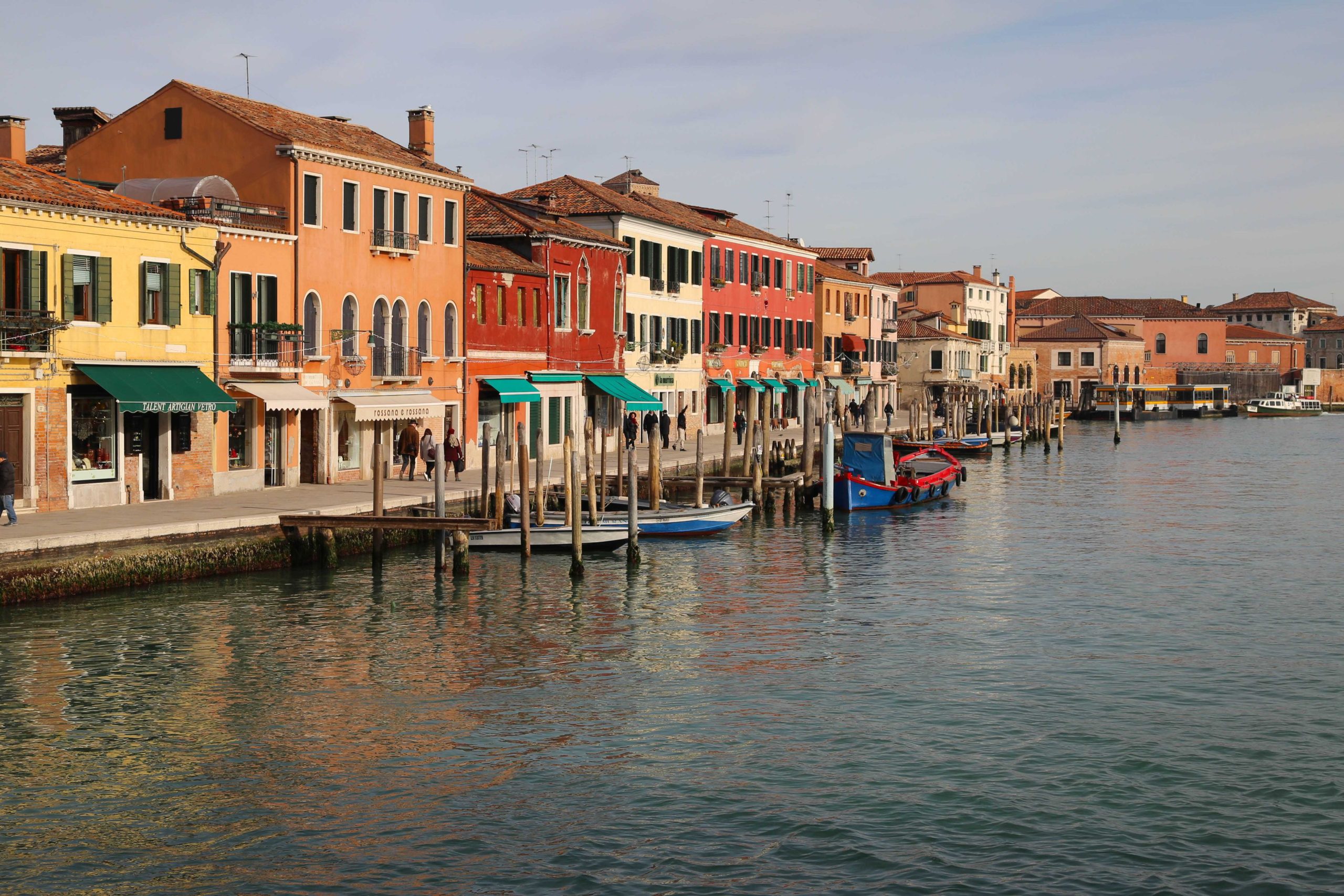
A canal on the island of Murano, like many of the islands in the Venetian Lagoon, epitomize a way of life that is intimately connected to the sea and the land.
As trade and commerce turned Venice into an economic and regional power, the city prospered. A wealthy group of elites grew, and their tastes in art, architecture, and finery increased. It is natural that demand for high quality glass products would be a part of that gentrification. In addition to relocating glass makers to Murano for safety, Venice was able to control, and thus protect, the intellectual property secrets of glass making. The city took further steps to protect the manufacturing process and elevate the status of glass makers. One decision was generous, the other onerous.
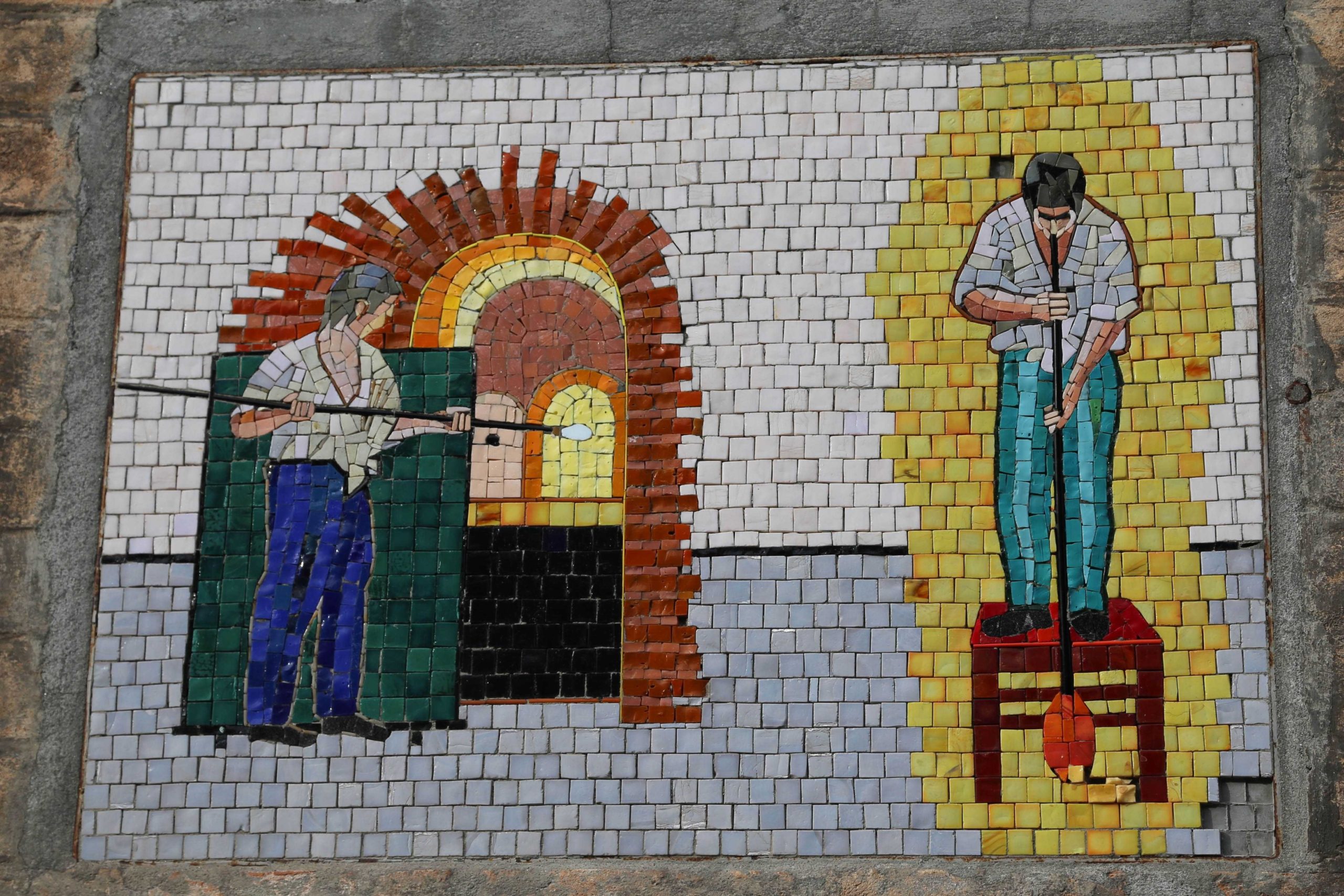
Glass making was considered such a highly regarded skill that glass blowers were allowed to marry into the nobility, carry swords, and earn a considerable amount of money. Leaving Murano — and taking trade secrets with you — was once an offense punishable by death.

Glass makers work for many years, perfecting their skills. Showrooms displaying intricate and huge pieces are available for viewing, but parts of some showrooms are off limits to photographers.
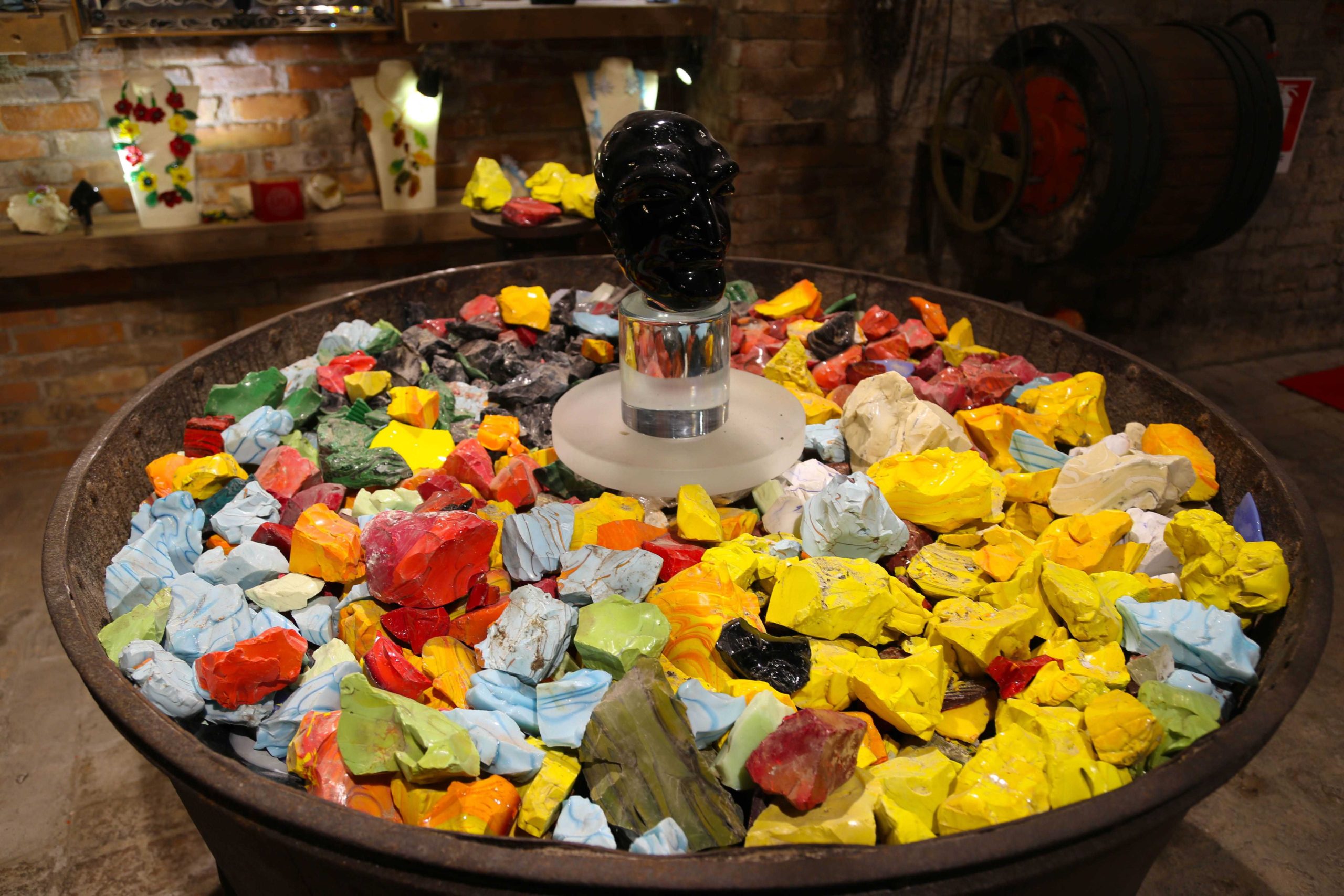
A color wheel of glass in varying shades suggests a myriad of possibilities that highly skilled glass makers can employ.
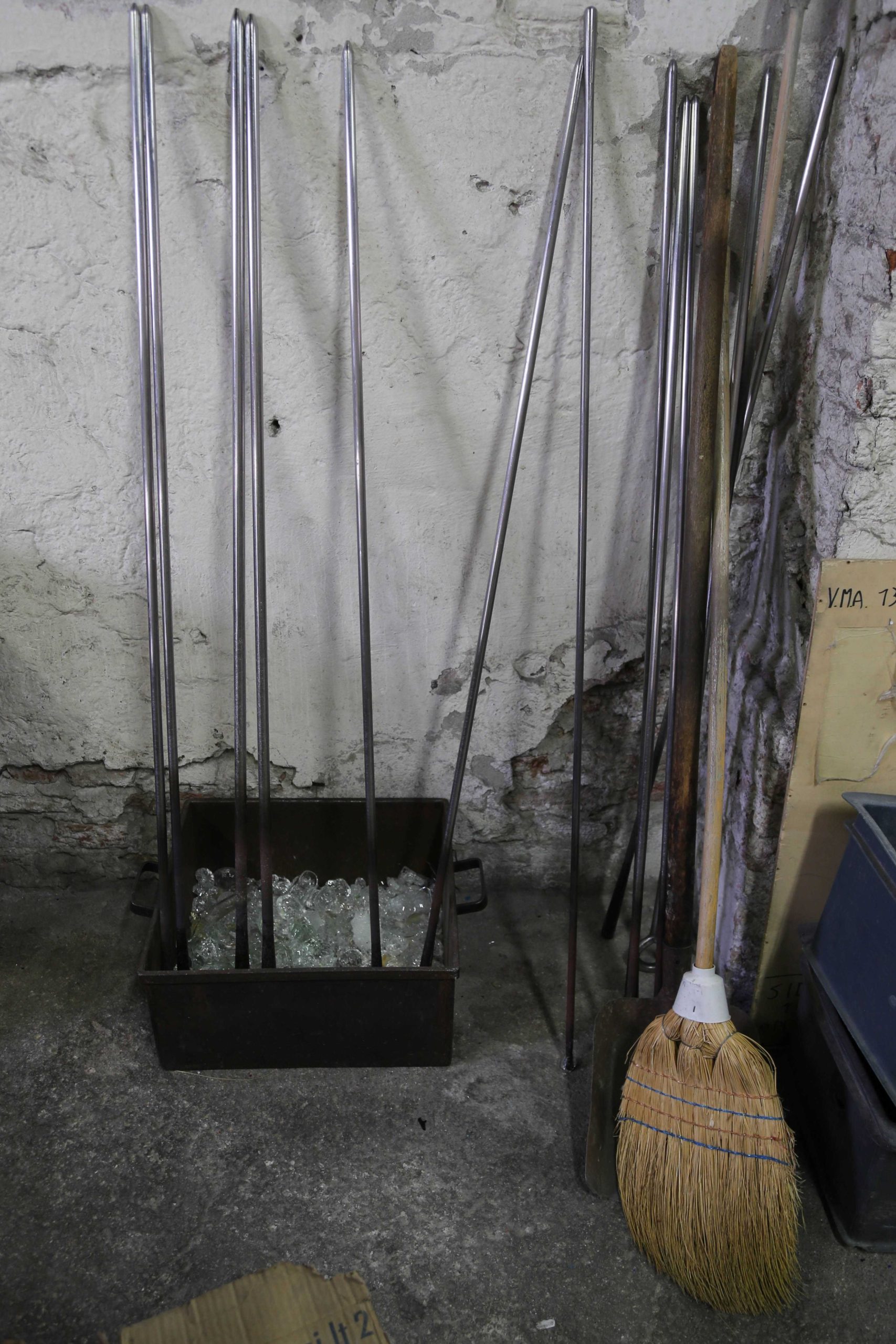
The shards and chips of rejected pieces have been relegated to a slag bin, possibly to be recycled and given another chance to become something beautiful and treasured.
Glass makers were held in such high regard they were granted the highest social status. They could carry swords, and were even allowed to marry members of the nobility. But, if a glass maker was caught trying to leave Murano and take their secrets with them, they faced a death penalty. That system worked well – for a time – but like all restrictive laws, glass makers left, and glassmaking spread throughout Europe, the British Isles, and beyond. But Murano retained its status as the center for the world’s finest glass products. By the 1600s around 7,000 residents lived on the seven islands that make up Murano. (The population is currently estimated to be around 4,500.)
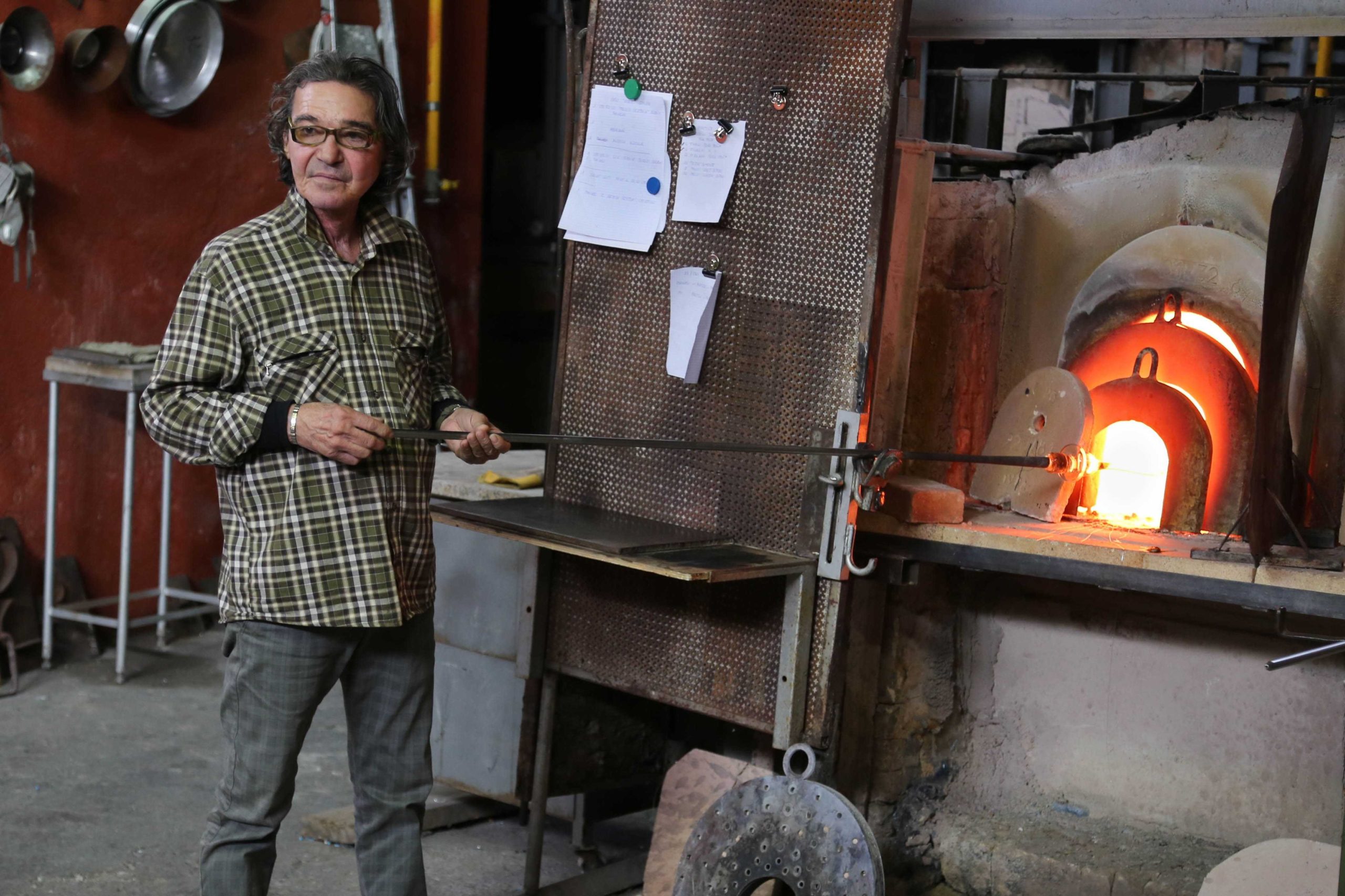
Signore Bardella heats up a parison, or glob of glass to begin making a small ornamental piece.

One of the first steps is to get the parison into an even and uniform shape by lightly rolling it on the metal table.
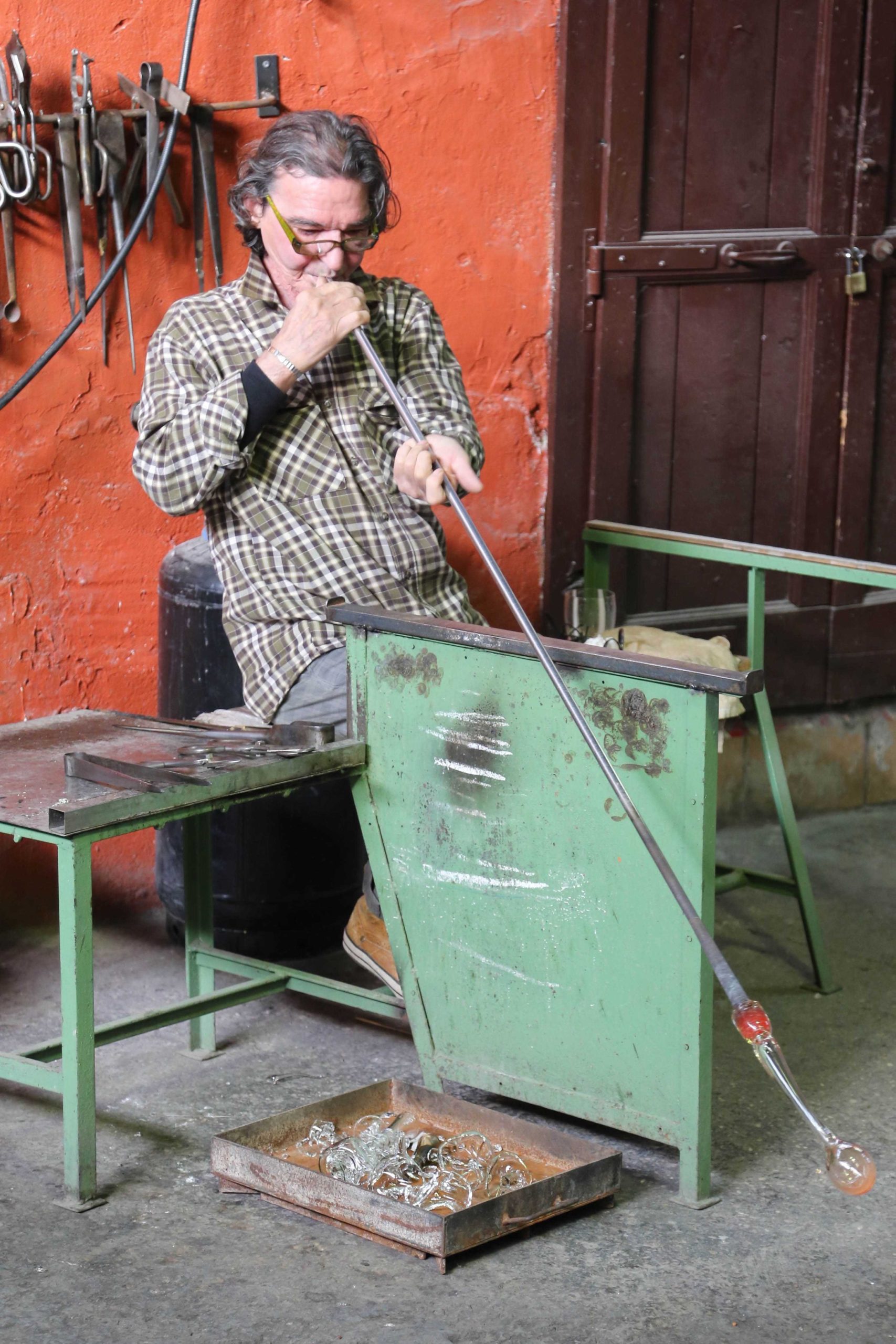
It’s not so much “glass blowing” as it is “glass puffing” because only a light, carefully-controlled amount of pressure is exerted through the blow pipe. Glass blowers must work quickly, paying attention to the temperature of the glass, returning it to the glory hole when necessary.
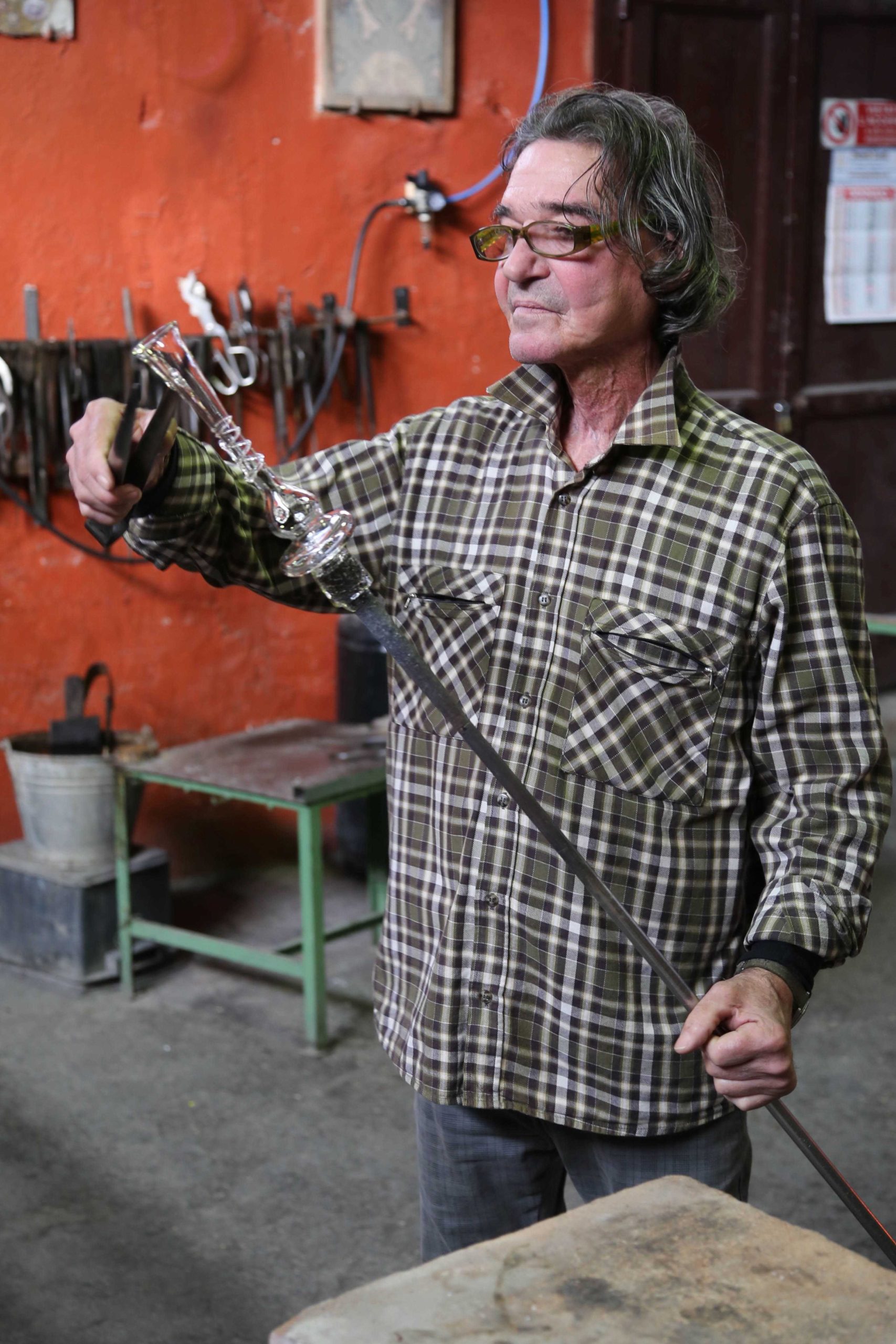
In the course of a few minutes Signore Bardella has transformed a blob of molten sand into a beautiful flower bud vase.

Skilled glass blowers like Signore Bardella can make any variety of shapes and objects, like this whimsical unicorn.
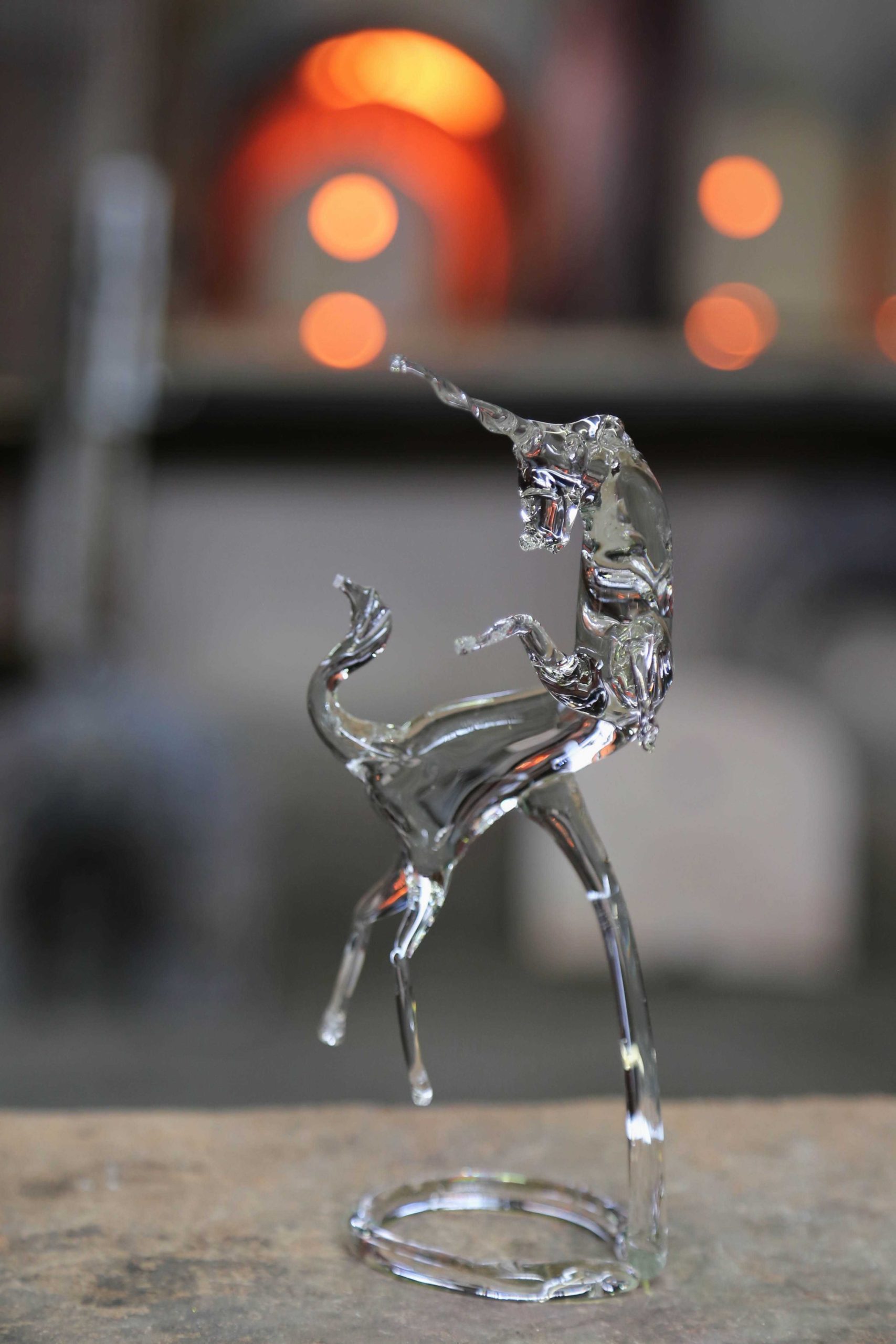
This delightful piece is created before you eyes, but it took years of learning and practice to hone his skill.
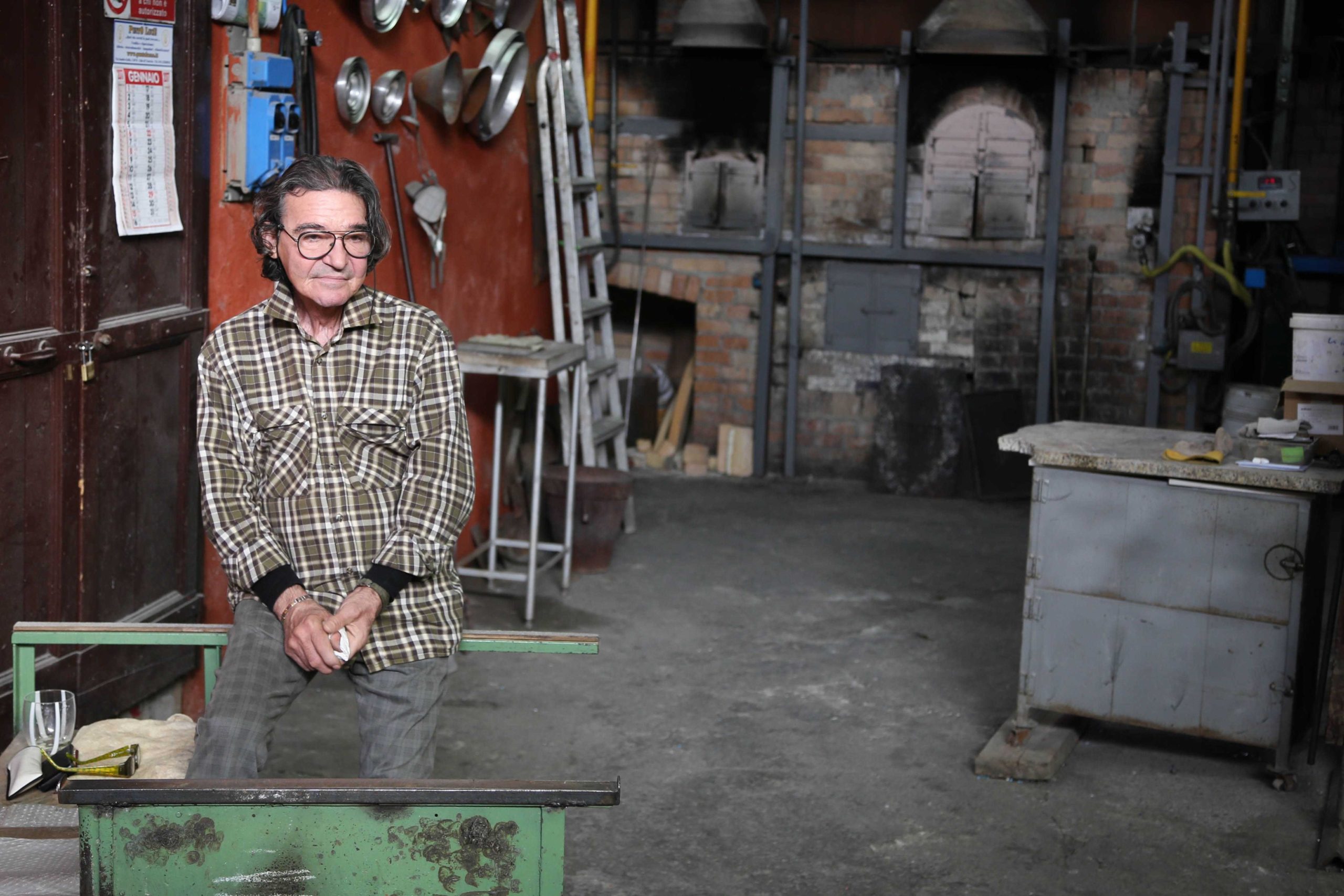
Signore Bardella relaxes in the studio after demonstrating his talents.
Over the centuries the glass studios of Murano produced items in demand throughout the world. Glass makers developed nearly a dozen distinct types, including crystal, mirrors, filigree, millefiori, milk glass, canes, and sommerso (where a colored glass is dipped into a clear molten glass. Chandeliers were elaborate and massive, and they adorned palaces, mansions, hotels, and businesses all over Europe and America – wherever people had money. But tastes in glass have changed and though huge chandeliers are not as generally coveted as they once were, the market for art glass has increased, so glass production on Murano continues. Clearly the world is a better place thanks to the beauty of glass produced on Murano.

The tools of a glass artist may look simple, but in skilled hands they can deftly manipulate glass into pieces that can be appreciated for centuries.
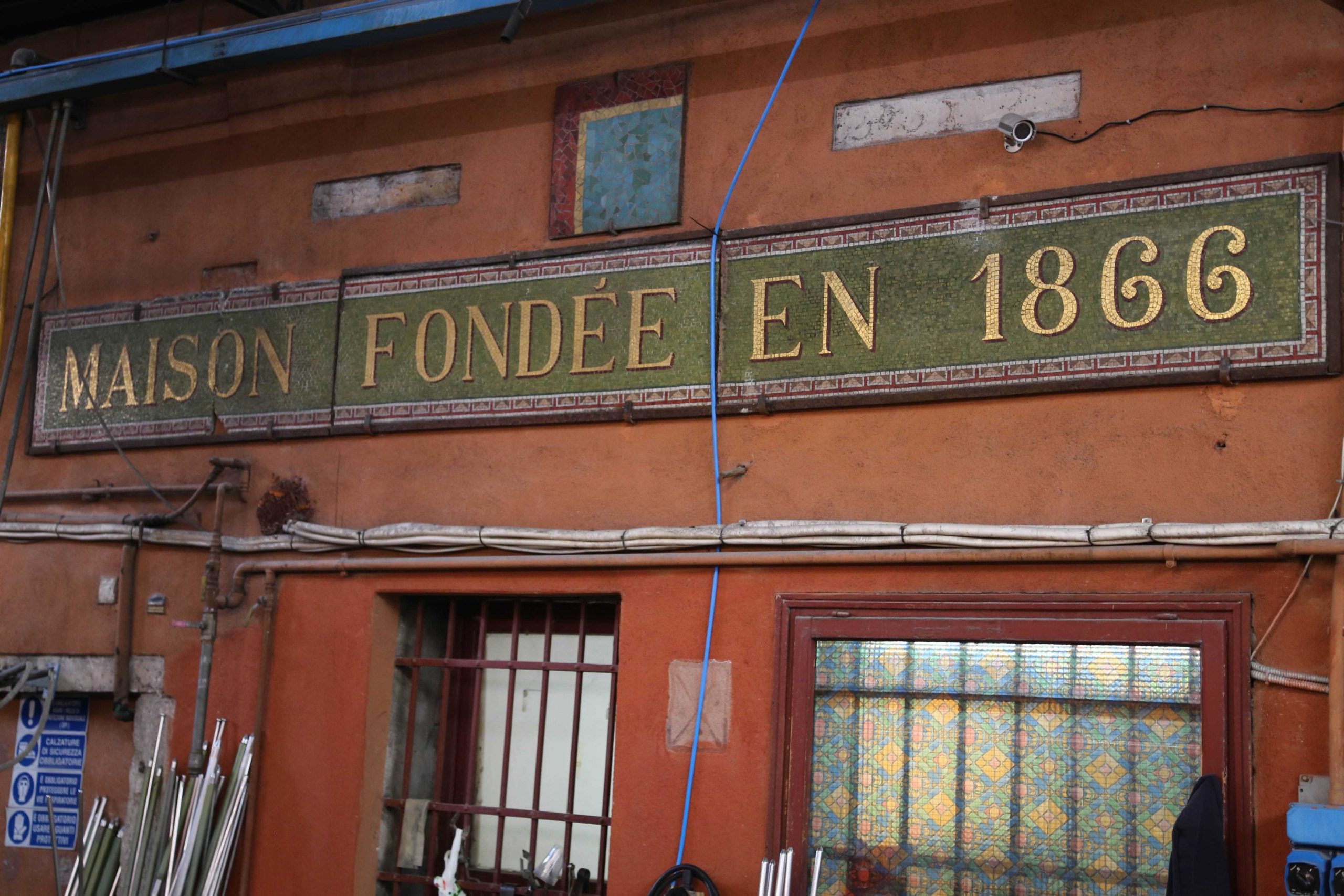
For more than 150 years this glass studio has been turning out an incredible variety of products owned and cherished by people around the world.
Sadly, Murano and the other islands of the Venetian Lagoon face greater challenges than the fickle whims of fashion and art. And while Murano’s legacy as a glass making center will always be there, the islands themselves may not because they are under assault from a changing climate; sea level rises, an increase in severe weather and storms, and delays and squabbles over mitigation projects threaten the very future of Venetian islands like Venice, Murano, and Burano. If protections are not quickly put in place then the glass furnaces of Murano may well be extinguished forever.

Once these glass furnaces, glory holes, and annealing ovens were a hive of activity…
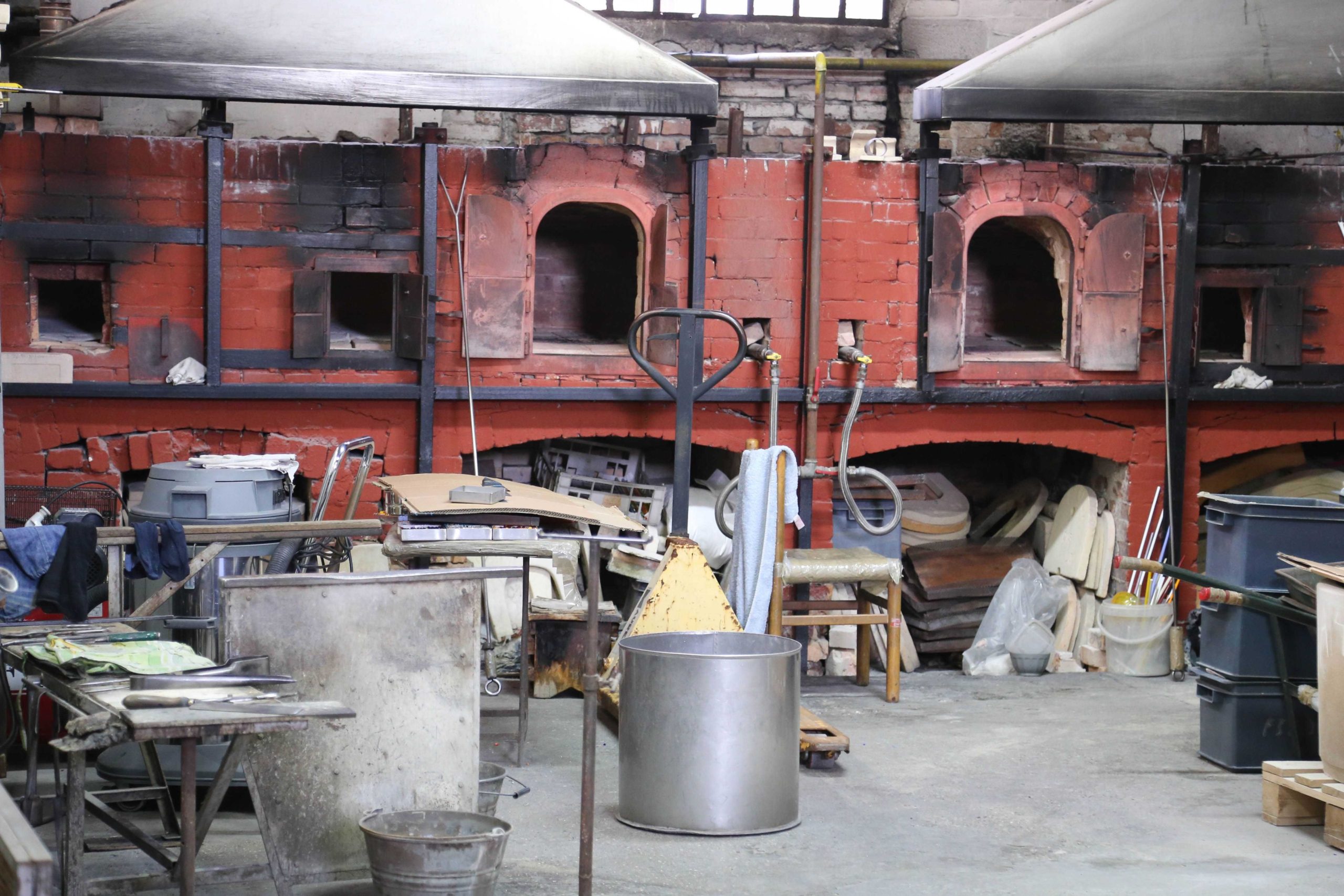
…but as the years have passed, the popularity of expensive, high-end glass products from Murano has waned.
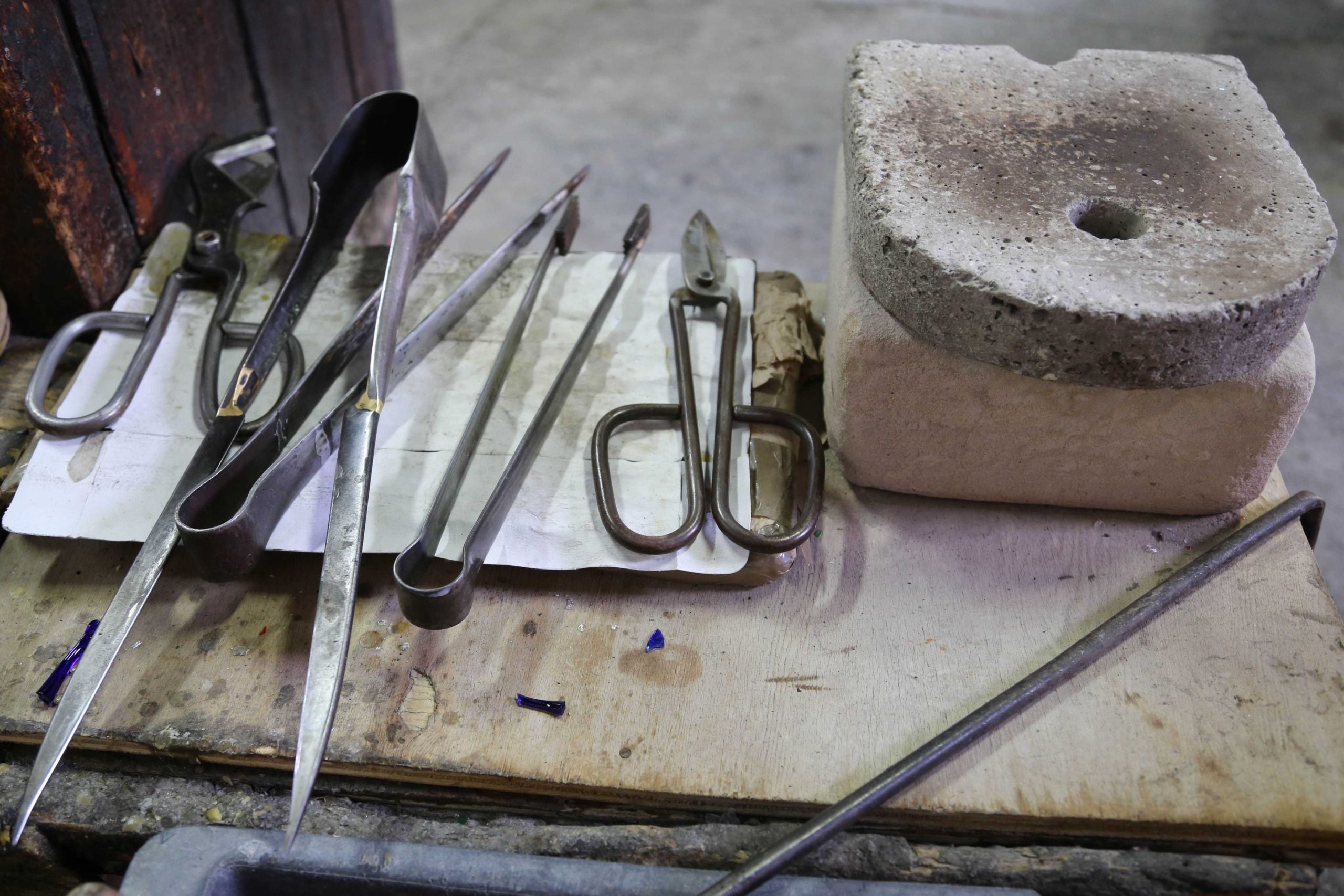
Now, many of the tools sit idle…
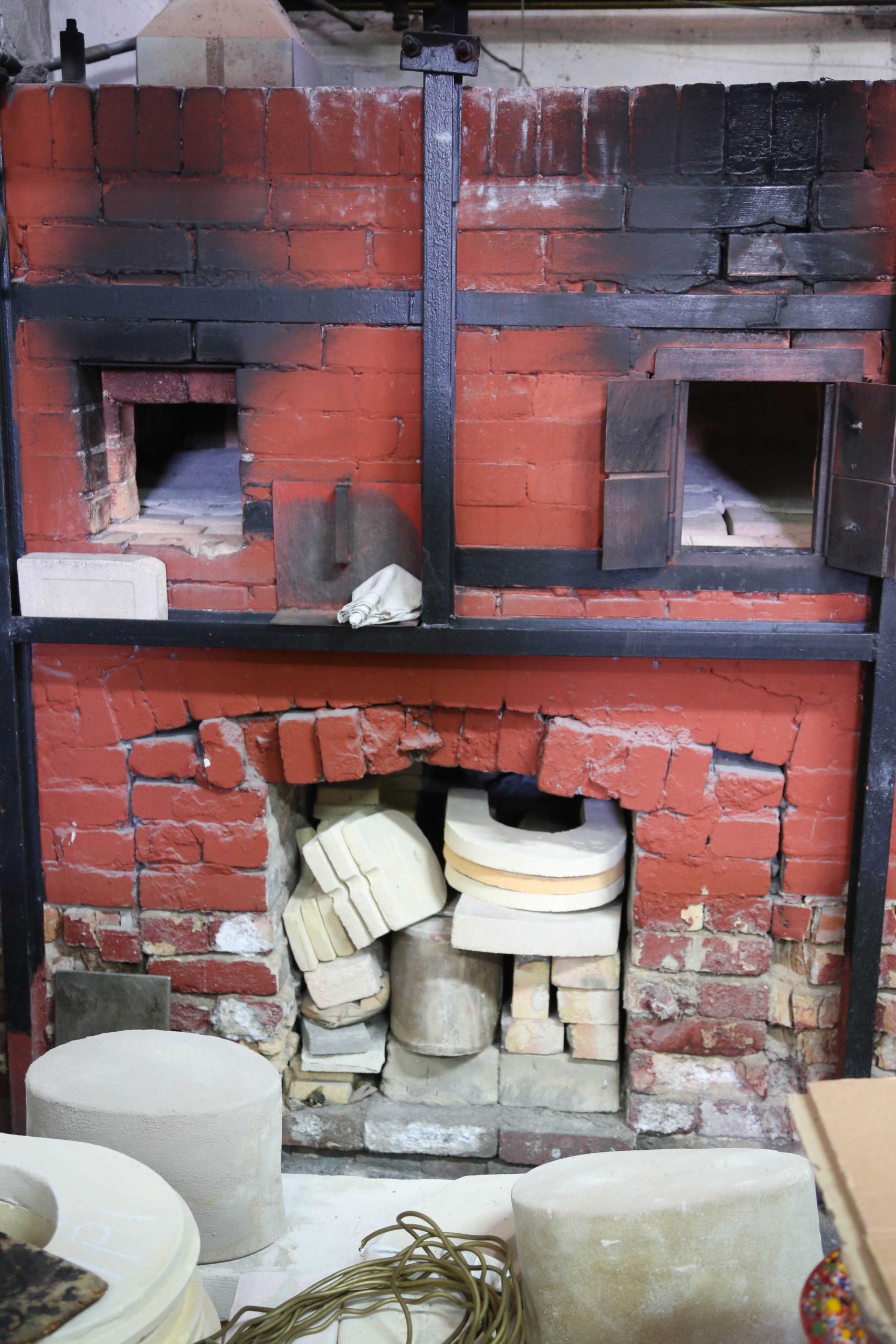
…as the fires of creativity wait to be reignited and put back to work.
For more information about Murano and the amazing glass products created there, click over to these websites:
europeforvisitors.com/murano_the_glass_island
veneziaautentica.com/murano-glass/
